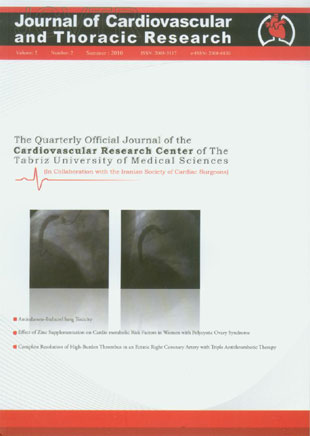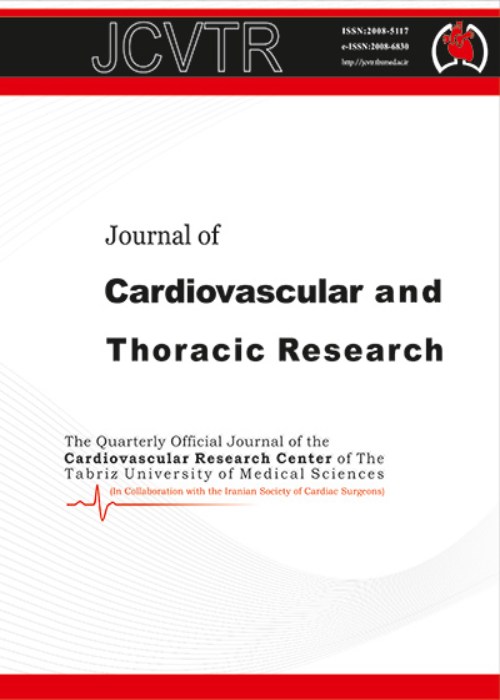فهرست مطالب

Journal of Cardiovascular and Thoracic Research
Volume:2 Issue: 2, May 2010
- تاریخ انتشار: 1389/08/29
- تعداد عناوین: 8
-
-
Pages 1-4Amiodarone is one of the most frequently prescribed antiarrhythmic agents worldwide. Although it is extensively used in the treatment of life-threatening arrhythmias, it can act as a double-edged sword considering its potentially serious side effects which warrants careful patient selection. This is a review of amiodarone induced pulmonary toxicity, and its associated risk factors, pathogenesis, diagnosis, treatment and prognosis.
-
Pages 5-10ST segment resolution (STR) following reperfusion therapy in STEMI patients has been shown to be a very strong predictor of outcome. Several studies investigated the strength of terminal QRS distortion (grade 3 ischemia) in predicting the failure of STR after reperfusion therapy. This study aimed to investigate whether grade 3 ischemia or other clinical characteristics could predict STR or not.MethodsIn this cross-sectional study, we enrolled 100 consecutive acute STEMI patients who were admitted during 12 hours after the onset of their chest pain. Baseline clinical characteristics, electrocardiogram at 90 min, 3 hours, and 24 hours after the initiation of thrombolysis therapy, and echocardiographic data were retrived from the patients’ medical records.ResultsThe mean age of patients was 59±12 years old (13-93 years). Eighty percent were men and 46% were smoker. Thirty eight (38%) patients had grade 3 ischemia on their admission electrocardiogram. The frequency of grade 3 ischemia was different among patients with and without STR at 90 min (P=0.01), 3 hours (P=0.04), and 24 hours (P=0.04) after the thrombolytic therapy. But when comparing the outcome of patients with grade 2 and 3 ischemia on admission ECG, there was no significant difference in the frequency of complete STR between two groups in different time points. Only the frequency of failure to STR (STR<30%) was different among patients with grade 2 and 3 ischemia, 24 hours after thrombolysis (P=0.03). Odds ratio for grade 3 ischemia in predicting failure to STR was 1.80 (with 95% CI: 0.6-5.2).ConclusionsThe presence of grade 3 ischemia on admission electrocardiogram was predictor of incomplete STR at 90 min, 3 h and 24 h after the initiation of thrombolysis and was associated with higher rates of coronary angiography and angioplasty.
-
Pages 11-20Studies suggest that polycystic ovary syndrome (PCOS) is associated with increased cardiovascular risk. Dyslipidemia, insulin resistance, hypertension, and central obesity are known as potent cardiovascular risk factors that tend to cluster in women with PCOS. This study was aimed to determine the effect of zinc supplementation on cardiometabolic risk factors in women with PCOS.MethodsSixty subjects with polycystic ovary syndrome were randomly divided into two groups to receive 50mg/d of zinc as zinc sulphate or placebo for 8weeks, as an adjunct to their pre-study oral estrogen-progestin compounds therapy. Measurements of insulin resistance, systolic-and diastolic blood pressure, serum zinc, lipids, and androgens levels, anthropometric indices and dietary intake, were taken at baseline and after 8weeks.ResultsAfter 8weeks, results were obtained by comparison of the change in the Zn group to the change in the placebo group. The zn group showed a significant increase in serum zn compared to the placebo group (p<0.0001) and there was a significant reduction in homeostasis model of assessment-insulin resistance score (mean change -15.3%) compared with the placebo group (mean change 0.5%, P<0.0001). Significant reductions were also seen in levels of fasting serum total cholesterol (P<0.01), LDL-C (p<0.01), triglyceride (P<0.0001), testosterone (p<0.05),and TG/HDL-C ratio (P<0.05) in the zinc group. Both groups showed insignificant changes in anthropometric indices and systolic-and diastolic blood pressure.ConclusionThis study demonstrates that zinc supplementation may represent an effective adjunctive nutritional therapy with the potential for improving lipid metabolism and insulin resistance in PCOS women.
-
Pages 21-27The purpose of this study is to provide insight into pathology patterns of cardiac valves, which remains a major cause of mortality and morbidity in Iran as a developing country.MethodsThis prospective study included 3418 consecutive cardiac surgery patients who underwent valve surgery over the past 5 years in 6 major hospitals. Etiologic and pathologic data of the valves were based on either pathologic reports (for replaced valves) or gross detection of the surgeons (for repaired valves).ResultsThe mean age of subjects was 43.98±14.45 years. 1616(47.27%) of them were male and 1802(52.73%) were female. Approximately 46% (1572) of the patients underwent mitral valve surgery.Mitral valve disease was found to be due to ischemia in 327(9.56), infective endocartidits in 68 (1.99), congenital problems in 71(2.08) and degenerative etiology in 264(7.72). Rheumatic valve disease was most frequent in patients of 40-49 years old.ConclusionsThis study shows that rheumatic valvular disease remains the most frequent valvular pathology among patients undergoing valvular surgery in Iran. The relatively high mean age of patients with rheumatic valvular disease emphasizes the priority of this health problem in Iran which requires particular attention, especially in terms of prevention and also treatment.
-
Pages 29-32Indoor air pollution other than smoking is an important factor affecting lung and is a major risk factor for chronic obstructive pulmonary disease (COPD) especially in developing countries. In Iran, the majority of housewives in rural communities use biomass fuel for cooking and space heating even in the living room, which is a common practice in winter. An attempt has been made to test the hypothesis that wether a relationship exists between the use of biomass fuel and chronic bronchitis in women who bake bread in a domestic setting.MethodsThis study was performed in pulmonary ward and outpatient clinics of Imam Khomeini hospital of Tabriz Iran university of medical sciences from November 2004 to march 2008.Forty two patients who were diagnosed with chronic bronchitis based on American Thoracic Society (ATS) criteria enrolled in our study. Data regarding historyand physical examination were collected for each patient. Chest X-ray, ECG, serum IgE, spirometry and transthoracic echocardiography were performed.ResultsAll patients fulfilled the criteria for COPD. Eighty five percent of patients had radiographic abnormalities. Seventy three percent of them had spirometric impairments. Serum IgE level in all of the cases were in the normal range. Significant pathologic findings were reported in all of the nine patients who underwent fiberoptic bronchoscopy for hemoptysis.ConclusionsCOPD is not uncommon among non-smokers and risk factors other than active cigarette smoking, such as biomass smoke, may contribute to airways obstruction and sometimes restrictive disease, severe pulmonary artery hypertension and significant pathologic changes. A new strategy in cooking in rural areas should be applied by governments.
-
Pages 33-36Increasie in bacterial resistance to broad spectrum antibiotics constitutes a major challenge in medicine. Enterobacteriaceae are among the important causes of nosocomial infections and mortality. This study was performed to evaluate the enterobacteriaceae resistance rate to broad spectrum Cephalosporins in Shahid Madani Heart Center and to determine the optimal antibiotic regimen for such cases.MethodsIn a cross-sectional descriptive study, 100 patients from heart surgery wards who were diagnosed with enterobacteriaceae infection in Shahid Madani hospital in 2009 were enrolled. After determination of bacteria type in microbiology laboratory by standard methods, the resistance of bacteria to cephalosporins were evaluated by disc diffusion agar method.ResultsResistance rate of enterobacteriaceae for ceftriaxone, ceftazidime, cefixime, cefotaxime, ceftizoxime and cefepime were 33%, 38%, 29%, 20%, 3% and 5% respectively. Among the third generation cephalosporins, ceftizoxime with a 3% resistance rate was found to be the most effectives and ceftazidime with 38% resistance rate the least effective. Ninety four percent of enterobactriaceae were sensitive to cefepime, a fourth generation cephalosporin.ConclusionThis study shows that third and fourth generation cephalosporin are more effective than first generations in the treatment of enterobacteriaceae infection among open heart surgery patients. A higher rate of resistance was reported in this study compared to the previous studies.
-
Pages 37-3958 year-old man was admitted with acute inferior myocardial infarction. One and a half million units of streptokinase were administered. The patient did not experience any other episode of chest pain. Coronary angiography performed 48 hours after admission showed normal left anterior descending and left circumflex arteries. Right coronary artery (RCA) contrast injection revealed an ectatic vessel with a large filling defect consistent with thrombus at its mid portion. Considering the patients stable condition, urgent intervention was avoided and triple therapy with Plavix, aspirin and enoxaparin was started. Control angiography 6 days later revealed complete trhrombous resolution. This case study shows that with proper case selection serious consequences of early invasive intervention such as distal embolization and no-reflow in these high risk patients could be avoided.
-
Pages 41-44Herein, we report a case of giant bulla of the right lung in a 35 year old woman. She had respiratory distress and non productive cough for four months. Computed tomography of the chest revealed a giant bulla of the right lung mimicking tension pneumothrax. Being diagnosed with pneumothrax she was treated with closed chest tube drainage and as her condition did not improve after chest tube insertion was referred to our center. Her condition didn’t improve even with the second chest tube insertion so we decided to procede with thoracotomy. By performing a right thoracotomy, a giant bulla with diameters of 30×25×25 cm was discovered and resected. Giant bulla should be included in the differential diagnosis of pneumothrax.


